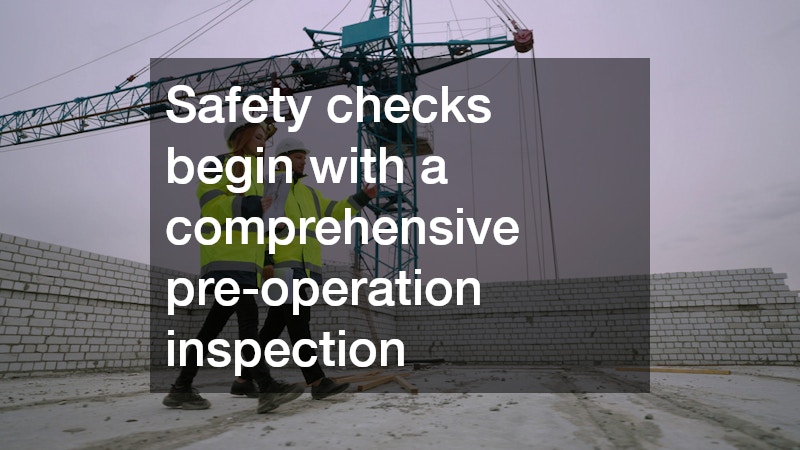
Ensuring the safety and efficiency of your project with crane rentals requires following essential guidelines. With construction and industrial operations often relying on heavy machinery, cranes play a pivotal role in lifting and maneuvering materials. Here, we cover vital tips and practices that help prevent accidents and maximize performance on job sites.
How Do I Select the Right Crane for My Job Site?
Assessing Job Site Conditions
Selecting the appropriate crane begins with a thorough assessment of the job site conditions. Each site presents unique challenges such as terrain types, weather, space constraints, and accessibility that significantly influence crane selection. Evaluating these conditions helps determine if a mobile crane, tower crane, or another type is more suitable for the job, especially when considering crane rentals to match specific site requirements.
It’s crucial to assess not only the spatial limitations but also the surrounding environment. This includes overhead obstructions, proximity to public roadways, and potential underground hazards. Understanding these factors helps in deciding crane placement to avoid any interference with ongoing operations or nearby structures. The environment also dictates whether additional safety gear or permissions are needed.
Understanding Lift Requirements
The next step in choosing a crane is clearly understanding the lift requirements. This involves knowing the weight of the materials to be lifted and the maximum height needed. Cranes have varying load capacities and operational limits, so a clear understanding of these factors ensures the selection of equipment that can safely and effectively meet project demands.
Additionally, consider the load cycle or frequency of lifts required throughout a workday. High-cycle operations might necessitate more durable machinery or rotations of rental units to avoid excessive wear. The chosen crane must be capable of maintaining optimal performance without compromising safety throughout intense work schedules.
Consulting with Crane Rental Experts
Working with an expert in crane rentals can streamline the decision-making process, ensuring that the right equipment is selected for your specific needs. These professionals possess extensive knowledge regarding crane models, capabilities, and potential limitations based on job site assessments. Engaging them early can provide valuable insights and recommendations tailored to your project goals.
Experts can assist in scheduling, logistics, and ensuring the integration of cranes into your project timelines efficiently. They may also offer advice on secondary attachments or parts that can enhance crane performance. When dealing with crane rentals, their input helps you avoid unnecessary costs and delays.
What Safety Checks Should Be Performed Before Crane Operation?
Pre-Operation Inspection
Safety checks begin with a comprehensive pre-operation inspection, a critical step in ensuring equipment readiness. This inspection includes scrutinizing the crane’s mechanical components, such as booms, hooks, wire ropes, brakes, and rigging hardware. Ensuring that parts are in optimal condition prevents malfunctions during operation.
An often overlooked but equally important aspect is verifying that all safety devices are functional. This includes checking alarms, cut-off systems, and limit switches. These mechanisms serve as essential safeguards against human error, alerting operators to potential issues or automatically halting operations if unsafe conditions are detected.
Reviewing Load Charts and Capacities
Reviewing load charts and capacities for your crane model is vital for understanding its operational limits. Load charts are specific to each crane type and configuration, detailing the maximum loads that can be handled at different boom angles and radii, which prevents overloading that could lead to catastrophic failures.
Operators and site supervisors should be well-versed with these charts to ensure that all lifts are carried out within safe parameters. Improper load handling can cause crane tip-overs or structural damage.
Ensuring Ground Stability and Load Path Safety
Ensuring ground stability is critical in crane operations, especially when working with crane rentals, as uneven or unstable surfaces can compromise the machine’s balance and efficiency. Operators should assess the firmness and load-bearing capacity of the ground to determine if additional support or stabilization measures like crane mats are required.
Additionally, establishing a clear load path ensures that loads are moved safely from one point to another without obstruction. This involves planning the route in advance, considering the height of the load, and potential hazards such as buildings and vehicles, and coordinating any necessary road closures or on-site traffic management.
What Are the Best Practices During Crane Operation?
Ensuring Proper Communication Among Crew
Proper communication is the cornerstone of safe crane operation, particularly with crane rentals, which necessitates clear, unambiguous exchanges among crew members. Protocols should establish hand signals and radio communication systems that everyone on site understands, ensuring all movements are executed precisely according to plan.
Having a designated signal person who relays directions between the crane operator and ground personnel is essential. This role requires keen awareness and quick responsiveness to changing circumstances, preventing miscommunications that could lead to operational errors.
Maintaining Safe Distances from Power Lines
One of the most critical safety considerations is maintaining appropriate distances from power lines and electrical conductors. Cranes operating near electrical sources risk contact that can cause fatal electrocutions. Regulatory guidelines specify minimum distances to be maintained to protect against such hazards.
Where operating within these distances cannot be avoided, additional precautions such as installing barriers or using proximity alarms to prevent accidental contact are essential. Awareness and preemptive planning prevent potentially severe accidents.
Implementing Emergency Procedures
Having robust emergency procedures is essential to job site safety and readiness. Emergency plans should be developed to cover potential incidents such as equipment failures, worker injuries, or environmental hazards. Practicing these procedures regularly ensures that responses are swift and effective.
Equipping the job site with necessary emergency equipment, such as first aid kits, fire extinguishers, and a communication plan to contact local emergency services, further enhances preparedness. These resources ensure immediate responses to incidents, protecting worker welfare and minimizing project disruptions.
Adhering to these safety tips ensures a safer, more efficient job site when utilizing crane rentals. These vigilant measures reduce risks and contribute to successful project outcomes. Prioritizing safety not only protects workers but also fortifies a project’s timeline and budget, aligning operational objectives with responsible industry standards.




